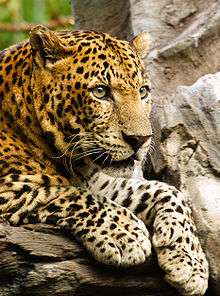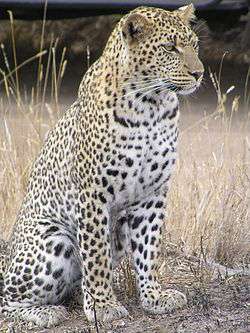Definify.com
Webster 1913 Edition
Leopard
Leop′ard
(lĕp′ẽrd)
, Noun.
[OE.
leopart
, leparde
, lebarde
, libbard
, OF. leopard
, liepart
, F. léopard
, L. leopardus
, fr. Gr. λεόπαρδος
; λέων
lion + πάρδοσ
pard. See Lion
, and Pard
.] (Zool.)
A large, savage, carnivorous mammal (
Felis leopardus
). It is of a yellow or fawn color, with rings or roselike clusters of black spots along the back and sides. It is found in Southern Asia and Africa. By some the panther (Felis pardus
) is regarded as a variety of leopard. Webster 1828 Edition
Leopard
LEOPARD
,Noun.
A rapacious quadruped of the genus Felis. It differs from the panther and the once in the beauty of its color, which is of a lively yellow, with smaller spots than those of the two latter, and disposed in groups. It is larger than the once and less than the panther. This animal is found in Africa and Asia, and so rapacious as to spare neither man nor beast.
Definition 2026
Leopard
Leopard
German

Noun
Leopard m (genitive Leoparden, plural Leoparden, feminine Leopardin)
Usage notes
The word may follow either weak or strong declension. In the genitive singular, it is almost always weak; in the accusative and dative however, both the weak and strong forms are possible, the former predominant in writing and the latter in speech.
Declension
leopard
leopard
English

A leopard
Alternative forms
Noun
leopard (plural leopards)
- Panthera pardus, a large wild cat with a spotted coat native to Africa and Asia, especially the male of the species (in contrast to leopardess).
- 1990, Dorothy L. Cheney, How Monkeys See the World: Inside the Mind of Another Species, 1992, page 284,
- During all such cases when we were present they responded by giving repeated alarm calls, even when the leopard was already feeding on a carcass. We wanted to determine whether vervets knew enough about the behavior of leopards to recognize that, even in the absence of a leopard, a carcass in a tree signaled the same potential danger as did a leopard itself.
- 1998, Oded Borowski, Every Living Thing: Daily Use of Animals in Ancient Israel, page 201,
- The leopard (Panthera pardus or Felis pardus cf tulliana) is a close relative of the lion, but biblical references mentioning it are very few, suggesting that it was not as common.
- 2005, Richard Ellis, Tiger Bone & Rhino Horn: The Destruction of Wildlife for Traditional Chinese Medicine, page 197,
- Leopard skins have always been desirable commodities because of their spectacular spotted patterns.
- 1990, Dorothy L. Cheney, How Monkeys See the World: Inside the Mind of Another Species, 1992, page 284,
- (inexact) The clouded leopard (Neofelis nebulosa), a similar-looking large wild cat native to Asia.
- 2005, Eric Dinerstein, Tigerland and Other Unintended Destinations, p. 81:
- There are plenty of beautiful cats among the thirty-nine species in the Felidae family, but the three leopards—clouded, common, and snow—may be the most visually stunning. Cloaked in the most beautiful fur of any cat, the reclusive clouded leopard is the Greta Garbo of the lot; it lives a solitary life in the remote jungles of Asia, from Nepal to Borneo.
- 2005, Eric Dinerstein, Tigerland and Other Unintended Destinations, p. 81:
- (inexact) The snow leopard (Uncia uncia), a similar-looking large wild cat native to Asia.
- (heraldry) A lion passant guardant.
- The lions on the English coat of arms are sometimes called leopards.
Hypernyms
Synonyms
- (Panthera pardus): common leopard, pard, pardal
- (Neofelis nebulosa): See clouded leopard
- (Uncia uncia): See snow leopard
Hyponyms
- (female): leopardess
- (young): cub, leopard cub
Derived terms
Derived terms
|
Related terms
Translations
a large wild cat with a spotted coat, Panthera pardus
|
|
See also
- (hybrid formed by a leopard and a lioness): leopon
- (hybrid formed by a lion and a leopardess): lipard
Anagrams
References
- ↑ Oxford English Dictionary, 1st ed. "leopard, n." Oxford University Press (Oxford), 1902.
- ↑ Oxford English Dictionary, 3rd ed. "pard, n.1" Oxford University Press (Oxford), 2005.
- ↑ Oxford English Dictionary, 3rd ed. "† pardal, n." Oxford University Press (Oxford), 2005.
Crimean Tatar
Etymology
From Latin leopardus (“leopard”).
Noun
leopard
Declension
Declension of leopard
| nominative | leopard |
|---|---|
| genitive | leopardnıñ |
| dative | leopardğa |
| accusative | leopardnı |
| locative | leopardda |
| ablative | leoparddan |
References
- Mirjejev, V. A.; Usejinov, S. M. (2002) Ukrajinsʹko-krymsʹkotatarsʹkyj slovnyk [Ukrainian – Crimean Tatar Dictionary], Simferopol: Dolya, ISBN 966-7980-89-8
Norwegian Bokmål
Noun
leopard m (definite singular leoparden, indefinite plural leoparder, definite plural leopardene)
- a leopard (big cat, Panthera pardus)
Derived terms
See also
Norwegian Nynorsk
Noun
leopard m (definite singular leoparden, indefinite plural leopardar, definite plural leopardane)
- a leopard (as above)
Derived terms
See also
Romanian
Etymology
From French léopard, Latin leopardus.
Pronunciation
- IPA(key): /ˌle.oˈpard/
- Hyphenation: le‧o‧pard
Noun
leopard m (plural leoparzi)
Declension
declension of leopard
| singular | plural | |||
|---|---|---|---|---|
| indefinite articulation | definite articulation | indefinite articulation | definite articulation | |
| nominative/accusative | (un) leopard | leopardul | (niște) leoparzi | leoparzii |
| genitive/dative | (unui) leopard | leopardului | (unor) leoparzi | leoparzilor |
| vocative | leopardule | leoparzilor | ||